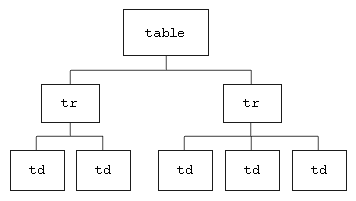What is the DOM?The Document Object Model is:
|
Code Examplesdocument.location.href
document.images[0].src
document.getElementsByTagName("h3").style.color
window.close()
|
The bad old days: Netscape 4 and the browser warsIn June of 1996, Netscape introduced the first beta version of Netscape 4. At the time, Netscape and Microsoft were still battling it out for dominance in the market so there was intense pressure to update the software with the latest whiz-bang features. Unfortunately for a generation of Web designers, Netscape guessed wrong about which elements of the nascent specifications were going to make it into the final version. Netscape 4 has been the bane of Web designers ever since due to its proprietary DOM and abysmal support of Cascading Stylesheets (CSS). Shortly thereafter, Microsoft introduced Internet Explorer 4.0 and another proprietary DOM along with it. At least IE supported CSS pretty well and their DOM enabled designers to more easily give users a dynamic browsing experience. |
Code Examples// Netscape 4 document.layers // Internet Explorer 4 document.all |
The good new days: modern browsers and standardsFast forward to July of 2003. Netscape 4 has a global market share of around 1% (this figure is higher at GW due to the legacy Netscape Calendar system). Internet Explorer 5.0 and above (which do a pretty good job of standards compliance) account for over 93% of global users. “Great!” you say, “The browser wars are over. Let’s all code for IE!” Not so fast … The same thing that happened to Netscape could happen to Internet Explorer. This is why it is important to code for standards rather than browsers.
|
Code Examples// modern browsers document.getElementById() document.getElementsByTagName() |
|||||
The modern DOMWhat did we learn above? The DOM is both:
The DOM as hierarchyConsider the following HTML snippet: <table> <tr> <td></td> <td></td> </tr> <tr> <td></td> <td></td> <td></td> </tr> </table> The DOM sees this as a hierarchy of elements as represented in the following diagram:
The DOM as collectionsConsider the following HTML snippet: <body> <img name="prods" src="products.gif" width="100" height="10" alt="Products"><br> <img name="servs" src="services.gif" width="100" height="10" alt="Services"><br> <img name="about" src="aboutus.gif" width="100" height="10" alt="About Us"><br> <img name="contc" src="contact.gif" width="100" height="10" alt="Contact Us"><br> </body>
The DOM organizes the images in the HTML above into an document.images[0] // this is the object corresponding to the first image document.images.0 // this is another way to represent the same image document.images["about"] // we can also reference images by name As we learned before, objects have properties and properties have values. Many of these values can be changed using JavaScript. This is what allows us, for example, to change an image when a user passes her mouse over it. <a href="products.html" onmouseover="document.images.prods.src='images/products_active.gif'" onmouseout="document.images.prods.src='images/products.gif'"> <img name="prods" src="images/products.gif" width="100" height="10" alt="Products"> </a> |
Browser detection versus object detectionThere are so many browsers out there (and so many that pretend to be a browser they’re not!) that it takes literally hundreds of lines of code to narrow down exactly which one a particular user is using. But, there is a better way! One handy byproduct of the browser wars is that it left a fairly dependable trail of broken DOMs to use as a basis for determining what browser the user is using. (Of course, we wouldn’t have to bother figuring this out if all browsers were standards compliant!) Using a technique called object detection, we can reliably determine the capabilities of a particular configuration in just a few lines of code.
A common example of this is to check for the function swapImage(imgName,imgSrc)
{
if (document.images)
{
document.images[imgName].src = imgSrc;
}
}
|
Code Examplesnn4 = false; // netscape 4.x
ie4 = false; // internet explorer 4.x
ie5up = false; // internet explorer 5.0 and above
modern = false; // other modern browsers
if (document.layers) nn4=true;
if (document.all && !document.getElementById) ie4=true;
if (document.all && document.getElementById) ie5up=true;
if (document.getElementById) modern=true;
if (modern == true)
{
// do standards compliant stuff
}
else
{
// do other stuff
}
|
Are you ready for another quiz? I thought so!
